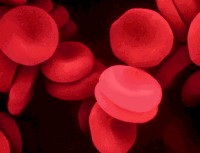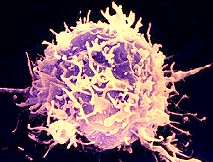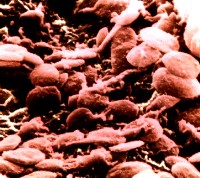
Blood is the fluid that circulates in the arteries and veins of your body. Your body uses it to carry oxygen to the cells through the arteries. Blood is bright red when it has oxygen in it, which it gets from the lungs. After it gives the oxygen to the body's cells, it becomes bluish red, and heads back to the heart through the veins, full of carbon dioxide and other waste products. It will then be sent to places where the waste can be disposed of ... the liver, kidneys and other organs will get rid of poisons, and the lungs will take out the carbon dioxide.
Blood is actually a mixture of many things. First, the liquid part is a yellowish fluid, called plasma. In this fluid are suspended cells that make up about 45 percent of the volume of whole blood These include red blood cells (erythrocytes), white blood cells (leukocytes) , platelets (thrombocytes), as well as other salts and organic substances in solution. In an average healthy adult, the volume of blood represents just under a tenth of the body weight, or about 5 litres.
Red blood cells (erythrocytes) carry oxygen, contained in the protein hemoglobin, where it is bound to iron atoms. These cells are what gives arterial blood its deep red colour. Hemoglobin in the red blood cells also transports nitric oxide, which regulates blood pressure by expanding or contracting blood vessel walls.
The cells carried by the blood are very tiny. A cubic millimeter of human blood contains about 5 million red blood cells. Red blood cells are formed in the bone marrow. After an average life of 120 days, they are broken down and removed by the spleen.
|

Red blood cells (erythrocytes)
|

White blood cells (leukocytes)
|
White blood cells (leukocytes) come in several varieties. Some of them destroy bacteria by 'eating' them; others help combat infections and allergies. Some white blood cells, called basophils, secrete heparin and histamine. Heparin keeps blood from clotting, and histamine stimulates inflammation.
Still others, called lymphocytes and monocytes, work with the immune system ... lymphocytes have an important role in producing antibodies and in cellular immunity, while monocytes destroy nonbacterial foreign substances, the result of chronic infection.
White blood cells are formed in various places, such as the bone marrow, the thymus, the spleen, liver, lymph nodes, and other organs.
|
Platelets (thrombocytes) are small round cells that have no nucleus, and are about one-third the size of red blood cells. Platelets are formed in the bone marrow.
Platelets stick to the walls of blood vessels wherever there is an injury, and help plug the hole in the vessel wall. As they disintegrate, they release clotting agents that help form thromboplastin, which makes a blood clot. A clot consists of red blood cells entangled in a web of fine threads made from fibrin, which is created at the site of the injury. This is the first step in healing the wound.
|

|

Plasma is the yellowish clear liquid that carries all the cells. Its main component is water. It also contains proteins, (like fibrinogen and prothrombin, which help with in clotting), inorganic elements and compounds such as sodium, potassium, calcium chloride, carbonate, and bicarbonate, as well as sugars and fats, hormones, enzymes, amino acids, and waste products such as urea. These various components of plasma are made in the liver, endocrine glands, and the lymphocytes. All these substances occur in tiny quantities, but there are a lot of them.
Blood Types
In the early 20th century, doctors discovered that blood transfusions often failed because the blood type of the recipient was not the same as that of the donor. The four blood types are now known as A , B , AB , and O.
Some of the different blood type cells carry antibodies which will kill other blood cells, so if the types are mixed, the blood cells destroy each other. Blood transfusions from a donor need to be the same type of blood as the recipient has.
Type O cells, however, don't have these antibodies, and so can usually be given to anyone. Type O is called 'universal donor' blood.
Type AB blood has no antibodies and can receive any of the four types of blood. Type AB is called 'universal recipient' blood.
Another blood component called the Rh factor also has an effect on which blood types can be given, particularly newborn babies.
|
Resources
|